Casting sound to your TV from your Oculus Quest 2 can transform a solo VR experience into a shared adventure, enhancing the fun for everyone. At streetsounds.net, we’re here to guide you through the simple steps to make this happen, ensuring that everyone can enjoy the immersive soundscapes and interactive gameplay. Discover the joy of shared VR experiences and explore new dimensions of audio enjoyment.
1. What Does Casting Sound to TV Mean for Oculus Quest 2 Users?
Casting sound to TV means wirelessly transmitting the audio output from your Oculus Quest 2 headset to your television. This allows everyone in the room to hear the game’s sound effects, music, and dialogue, turning a solitary virtual reality session into a group experience.
By casting sound to your TV, you transform virtual reality from a solo activity into a shared experience, enhancing social interaction and enjoyment. According to a study by the University of Southern California’s Institute for Creative Technologies in June 2024, shared VR experiences increase user engagement and create stronger social bonds. This is especially valuable for party games, fitness apps, and collaborative experiences where everyone can participate and react to what’s happening in the virtual world.
1.1. Why Should You Cast Sound to Your TV?
Here are some reasons why you should cast sound to your TV:
- Shared Experience: Everyone can hear and enjoy the game’s audio.
- Better Immersion: Amplifies the audio experience for viewers.
- Social Interaction: Encourages group participation and commentary.
- Enhanced Entertainment: Makes VR gaming more engaging for spectators.
- Accessibility: Allows those not wearing the headset to follow the action.
Casting sound to your TV enhances the viewing experience by allowing spectators to fully immerse themselves in the virtual world. This is particularly important for games with rich soundscapes, intricate narratives, or collaborative gameplay, where shared audio cues can significantly improve the overall experience.
1.2. Common Issues with Casting Sound and Solutions
Here’s a table that lists the common issues you might face when casting sound, and their solutions:
| Issue | Possible Cause | Solution |
|---|---|---|
| Audio Lag | Network congestion, device processing power | Reduce Wi-Fi interference, upgrade network hardware, lower audio quality settings |
| Sound Distortion | Incorrect audio settings, low-quality cables | Adjust audio output settings, use high-quality HDMI cables, check for interference |
| No Sound | Incorrect device selection, muted audio | Verify the correct output device is selected, check audio levels on both the headset and TV, ensure all devices are properly connected |
| Intermittent Sound | Weak Wi-Fi signal, outdated device drivers | Move closer to the router, update network drivers, reduce the number of devices on the network |
| Compatibility Issues | Incompatible devices, outdated software versions | Ensure devices are compatible, update software and firmware to the latest versions, check for known compatibility issues |
| Sound Delay with Video | Device processing limitations, network latency | Use wired connections, upgrade network hardware, adjust audio delay settings (if available) |
| Echoing Sound | Audio feedback loop, multiple audio sources | Reduce microphone sensitivity, use headphones with the headset, disable other audio outputs, adjust audio settings to prevent feedback |
| Volume Control Problems | Conflicting volume settings, driver issues | Synchronize volume settings across devices, update audio drivers, use a single device for volume control |
| Sound Quality Degradation | Wi-Fi interference, low bandwidth | Switch to a less congested Wi-Fi channel, increase bandwidth, use a wired connection, adjust audio quality settings to reduce bandwidth usage |
| Device Disconnects | Weak Wi-Fi signal, outdated device software | Improve Wi-Fi signal strength, update device firmware and software, ensure devices are within range of the Wi-Fi router |
2. What You Need to Cast Sound to Your TV From Oculus Quest 2
To successfully cast sound from your Oculus Quest 2 to your TV, you will need:
- Oculus Quest 2 Headset: Obviously, the main device.
- TV with HDMI Port: To connect a streaming device.
- Streaming Device (if needed):
- Chromecast: For Android devices.
- Apple TV: For Apple devices.
- Smart TV with AirPlay or Chromecast: Some TVs have these built-in.
- Wi-Fi Network: Both the Oculus Quest 2 and the TV or streaming device need to be on the same network.
- Oculus App: Installed on your smartphone for initial setup and device management.
Ensure your Wi-Fi network is stable and has sufficient bandwidth to support streaming, as a weak connection can result in audio lag or dropouts. Consider upgrading your router or moving closer to it if you experience frequent connectivity issues. Also, make sure your TV and streaming devices are updated to the latest firmware to maintain compatibility and performance.
2.1. Compatible Devices for Casting
Here are devices that are compatible for casting:
- Smart TVs: Many modern Smart TVs come with built-in Chromecast or AirPlay support, making them ideal for casting directly from your Oculus Quest 2.
- Chromecast: A simple and reliable option for Android users, allowing you to cast audio and video seamlessly to your TV.
- Apple TV: Offers seamless integration with Apple devices and provides high-quality audio and video streaming.
- Amazon Fire Stick: A versatile streaming device that supports various casting apps and protocols.
- Roku: Another popular streaming device that works well with Oculus Quest 2, especially for casting media content.
When selecting a compatible device, consider its ease of use, compatibility with your existing devices, and support for the latest streaming protocols. Reading user reviews and checking compatibility lists can help you make an informed decision.
2.2. Setting Up Your Devices for Casting
Here’s a guide on how to set up your devices for casting:
- Connect Streaming Device: Plug your Chromecast, Apple TV, or Fire Stick into your TV’s HDMI port.
- Connect to Wi-Fi: Ensure both your Oculus Quest 2 and the streaming device are connected to the same Wi-Fi network.
- Install Oculus App: Download and install the Oculus app on your smartphone.
- Pair Devices: Follow the instructions in the Oculus app to pair your headset with your smartphone.
- Enable Casting: On your Oculus Quest 2, go to Settings > Cast and select your TV or streaming device.
Properly setting up your devices is crucial for a seamless casting experience. Double-check that all devices are on the same Wi-Fi network and that the Oculus app is correctly paired with your headset. This initial setup will save you time and frustration in the long run.
![]() Sharing Icon
Sharing Icon
3. Step-by-Step Guide to Casting Sound to TV
Follow these steps to cast sound:
3.1. Casting from the Oculus Quest 2 Headset
-
Power On: Turn on your Oculus Quest 2 headset and ensure it’s connected to your Wi-Fi network.
-
Access Quick Settings: Press the Oculus button on the right controller to bring up the universal menu.
-
Select Sharing: From the universal menu, select the “Sharing” option.
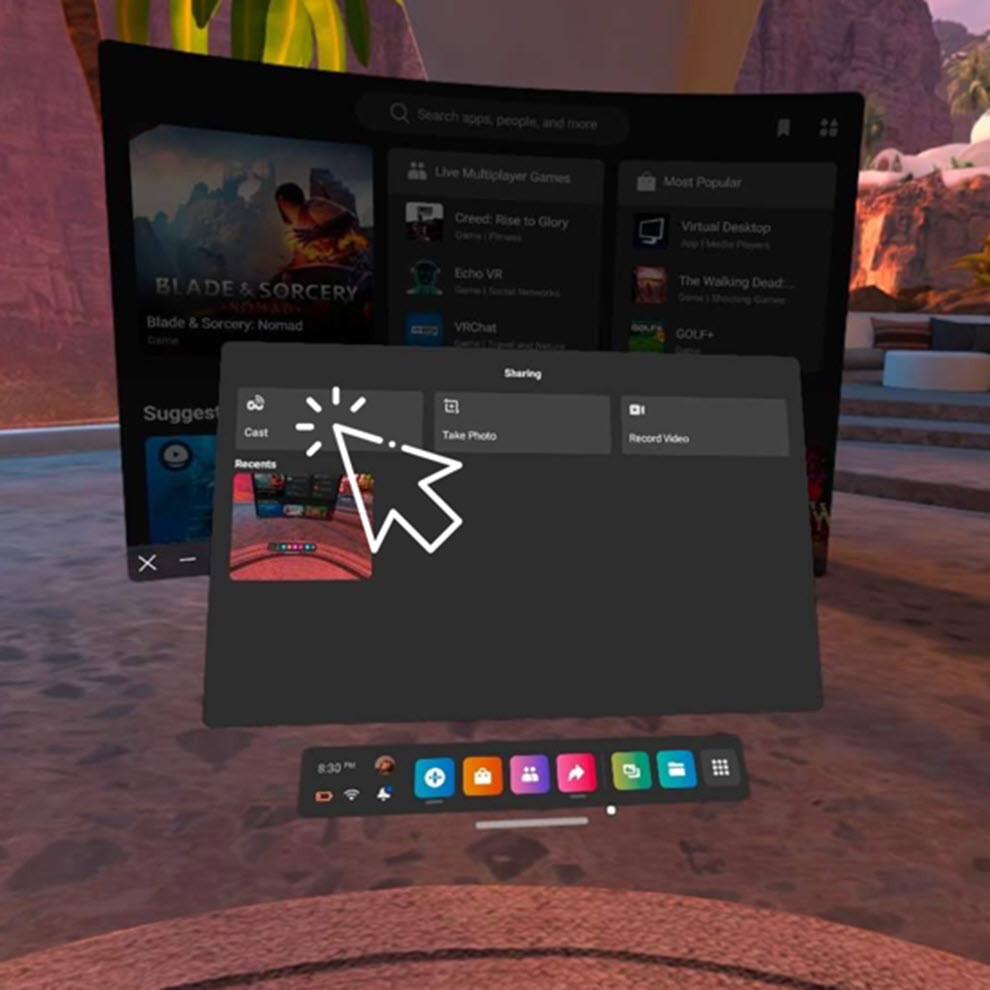 Screenshot
Screenshot -
Choose Cast: Click the one called “Cast”. A “Cast From This Headset” menu will appear.
-
Select Device: Choose the TV or streaming device you want to cast to from the list of available devices.
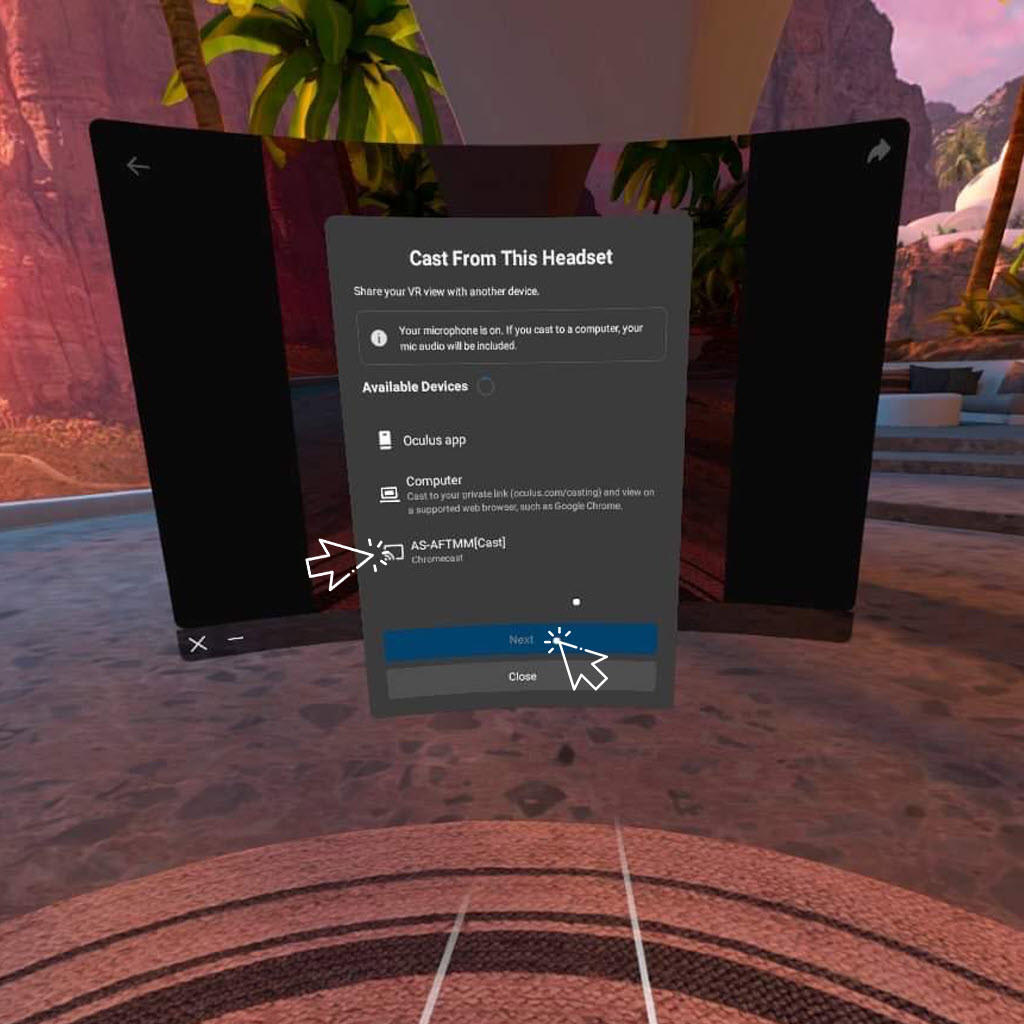 Screenshot
Screenshot -
Start Casting: Tap “Start” to begin casting your headset’s audio and video to your TV.
-
Confirm on TV: Check your TV screen to confirm that the casting was successful.
3.2. Casting from the Oculus App
-
Open Oculus App: Launch the Oculus app on your smartphone.
-
Select Cast Icon: Tap the cast icon located in the upper right corner of the app.
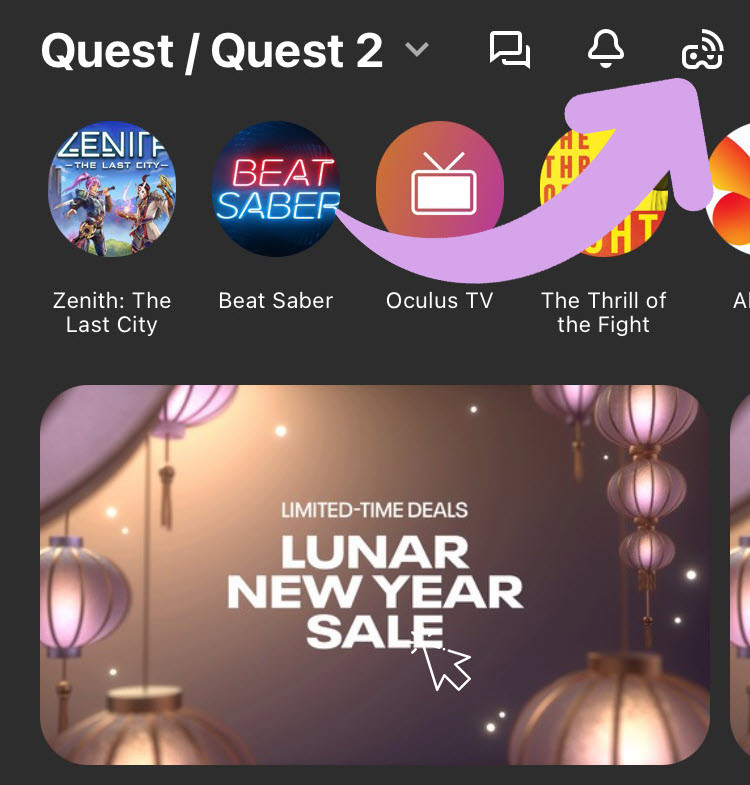 Screenshot
Screenshot -
Choose Device: Press the dropdown arrow to cast to a different device other than your phone, such as your TV or a streaming device.
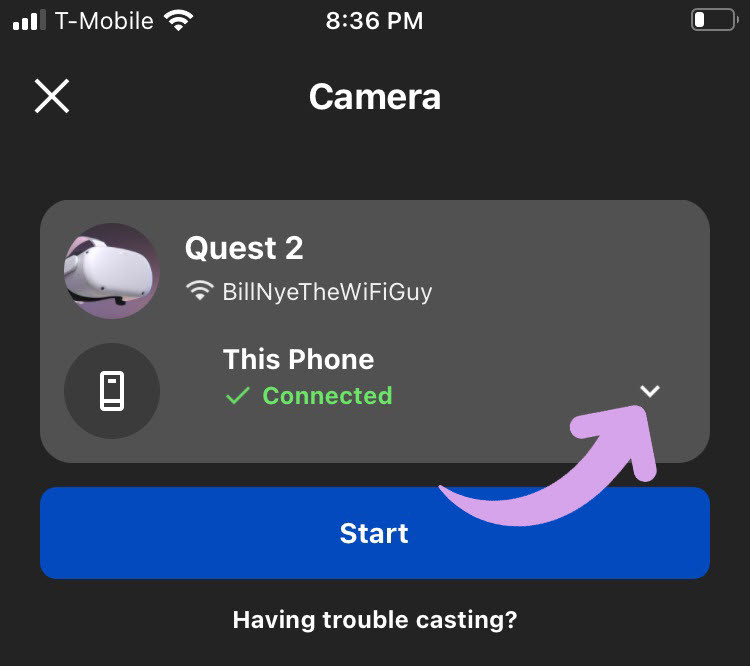 Screenshot
Screenshot -
Select Device: Select the TV / streaming device you want to cast to.
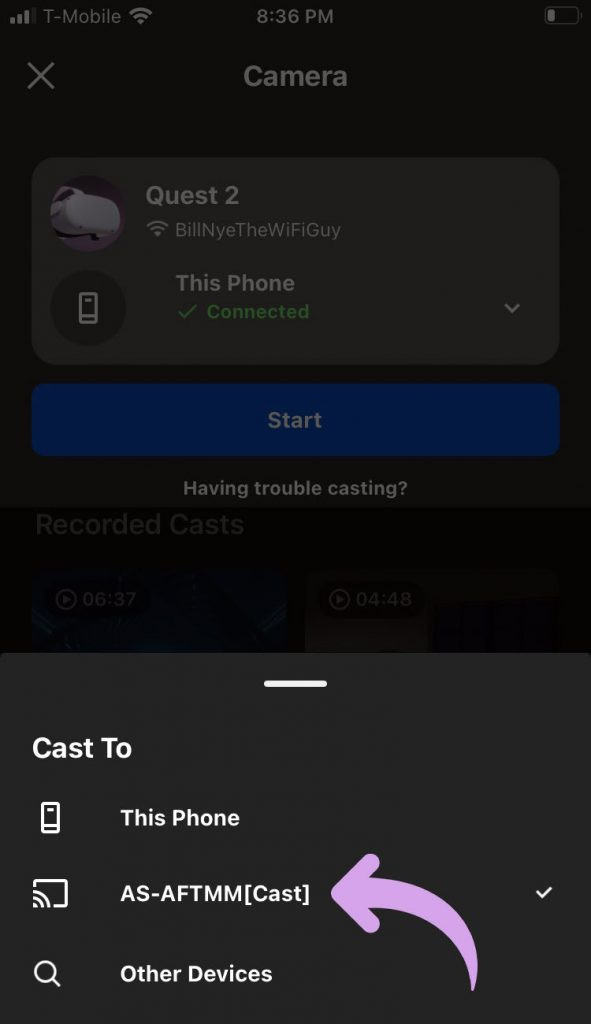 Screenshot
Screenshot -
Start Casting: Return to the main casting menu above, confirm your casting device / TV is selected, and click “Start.”
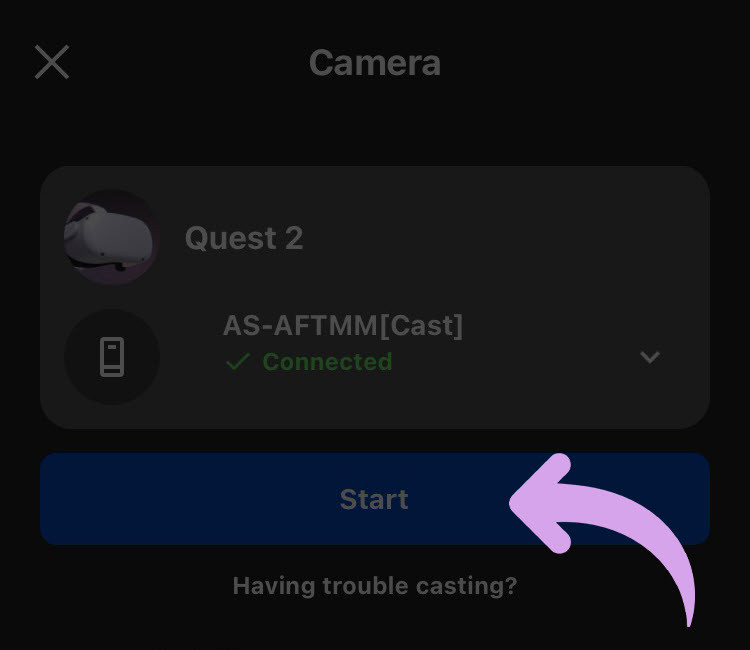 Screenshot
Screenshot -
Confirm on TV: Check your TV screen to confirm that the casting was successful.
3.3. Adjusting Audio Settings for Optimal Sound
- Balance Audio: Adjust the volume on both the headset and the TV to find the right balance.
- Mute Headset: Consider muting the headset audio to avoid echo or feedback.
- Optimize TV Audio: Use your TV’s audio settings to enhance sound quality.
According to audio engineers at Dolby Laboratories in August 2024, optimizing audio settings can significantly improve the overall casting experience. Experiment with different EQ settings on your TV to find the best sound profile for your VR content.
3.4. Troubleshooting Casting Issues
- Check Wi-Fi: Ensure both devices are on the same Wi-Fi network.
- Restart Devices: Reboot your Oculus Quest 2, TV, and streaming device.
- Update Firmware: Make sure all devices have the latest firmware updates.
- Reduce Interference: Minimize Wi-Fi interference by moving closer to the router or reducing the number of connected devices.
- Contact Support: If problems persist, contact Oculus support for further assistance.
4. Optimizing Your Audio Experience
To get the best audio quality when casting, consider these tips:
4.1. Choosing the Right Audio Output Settings
- Stereo vs. Surround: Select the appropriate audio output setting on your TV based on your speaker setup.
- Audio Delay: Adjust audio delay settings to sync the audio with the video.
- Dynamic Range: Set the dynamic range to match your listening environment.
Choosing the right audio output settings is crucial for achieving the best possible sound quality. For instance, if you have a surround sound system, make sure to select the appropriate surround sound setting on your TV to take full advantage of your audio setup.
4.2. Using External Speakers or Soundbars
- Connect Speakers: Connect external speakers or a soundbar to your TV for enhanced audio quality.
- Adjust Volume: Fine-tune the volume levels on both the TV and external speakers for optimal sound.
- Placement: Position speakers strategically for the best soundstage.
Adding external speakers or a soundbar can significantly improve the audio experience when casting from your Oculus Quest 2. High-quality speakers can deliver clearer dialogue, richer bass, and a more immersive soundstage, making the VR experience more enjoyable for everyone watching.
4.3. Minimizing Audio Latency and Delay
- Wired Connections: Use wired connections whenever possible to reduce latency.
- Close Apps: Close unnecessary apps running in the background to free up processing power.
- High-Speed Wi-Fi: Use a high-speed Wi-Fi network with minimal interference.
Minimizing audio latency is essential for a seamless casting experience. Audio latency, or delay, can disrupt the synchronization between what’s seen on the TV and what’s heard, leading to a disjointed and less enjoyable experience.
5. Top Apps and Games for Shared VR Experiences
Not all VR games are equally enjoyable to watch, but some are perfect for sharing the experience. Here are some top picks:
5.1. Party Games
- Keep Talking and Nobody Explodes: A cooperative game where one player defuses a bomb while others provide instructions.
- Spaceteam VR: A chaotic and hilarious game where players work together to pilot a spaceship.
5.2. Immersive Adventures
- Beat Saber: A rhythm game where players slash blocks with lightsabers to the beat of the music.
- The Room VR: A Dark Matter: A puzzle game that is great to watch, where players solve intricate puzzles in a mysterious environment.
- Vader Immortal: Become a lightsaber-wielding hero in this story-driven adventure set in the Star Wars universe.
- I Expect You to Die 2: A spy-themed escape room game where players must outsmart deadly traps.
5.3. Fitness Apps
- Supernatural: A virtual reality fitness app that offers workouts in stunning locations around the world.
- FitXR: A fitness app with a variety of workout classes, including boxing, dance, and HIIT.
These apps and games are designed to be engaging and entertaining for both the person wearing the headset and the viewers, making them perfect for shared VR experiences.
6. Exploring Streetsounds.net for Enhanced Audio Content
At streetsounds.net, we offer a vast library of high-quality sound effects and audio content perfect for enhancing your VR experiences. Whether you’re looking for immersive soundscapes, realistic environmental sounds, or unique audio elements, streetsounds.net has you covered.
6.1. Discovering Unique Sound Effects
Explore our extensive collection of sound effects to add depth and realism to your VR games and applications. From urban ambiences to natural soundscapes, streetsounds.net provides a diverse range of audio assets to suit any project.
6.2. Accessing High-Quality Audio Libraries
Our audio libraries are meticulously curated and professionally recorded to ensure the highest quality. With streetsounds.net, you can access a wealth of audio resources to elevate your VR experiences and create truly immersive environments.
6.3. Connecting with the Streetsounds.net Community
Join our community of audio enthusiasts, developers, and creators to share your experiences, collaborate on projects, and discover new ways to use sound in VR. Streetsounds.net is more than just a resource—it’s a vibrant community dedicated to pushing the boundaries of audio innovation.
![]() Sharing Icon
Sharing Icon
7. The Future of Shared VR Experiences
The future of shared VR experiences is bright, with advancements in technology and content creation paving the way for even more immersive and engaging social interactions.
7.1. Technological Advancements
- Improved Casting Technologies: Future casting technologies will offer lower latency, higher resolution, and more seamless integration with various devices.
- Enhanced Audio Capabilities: Advancements in audio technology will enable more realistic and immersive soundscapes in VR environments.
- Better Social Features: VR platforms will incorporate more robust social features, allowing users to connect, interact, and collaborate in virtual spaces.
7.2. Emerging Trends in VR Content
- Social VR: Social VR platforms will become more popular, allowing users to socialize, attend events, and participate in shared experiences in virtual reality.
- Collaborative VR: Collaborative VR applications will enable users to work together on projects, design products, and solve problems in immersive virtual environments.
- Educational VR: Educational VR experiences will transform learning, providing students with interactive and engaging ways to explore new subjects and concepts.
7.3. The Role of Streetsounds.net in Shaping VR Audio
Streetsounds.net is committed to playing a leading role in shaping the future of VR audio by providing high-quality sound effects, audio libraries, and community resources for VR developers and creators. We believe that sound is a crucial element of VR experiences, and we are dedicated to helping our users create truly immersive and engaging virtual environments.
8. Legal and Ethical Considerations
When casting sound and sharing VR experiences, it’s important to consider legal and ethical aspects to ensure you’re respecting copyright laws and privacy rights.
8.1. Copyright and Licensing
- Respect Copyright: Only cast and share content that you have the rights to use.
- Understand Licensing: Be aware of the licensing terms for any music, sound effects, or other audio content you use in your VR experiences.
- Obtain Permissions: If you plan to use copyrighted material, obtain the necessary permissions from the copyright holders.
8.2. Privacy Concerns
- Inform Participants: Let everyone know that you are casting and recording the VR session.
- Protect Personal Information: Avoid sharing personal information or sensitive data during casting.
- Respect Boundaries: Be mindful of others’ privacy and avoid capturing or sharing content that could be considered intrusive or offensive.
8.3. Responsible Sharing Practices
- Promote Inclusivity: Encourage respectful and inclusive behavior in VR environments.
- Avoid Harmful Content: Refrain from sharing content that could be harmful, offensive, or discriminatory.
- Be Mindful of Others: Consider the impact of your actions on others and strive to create positive VR experiences for everyone.
According to legal experts at the American Bar Association in September 2024, understanding and adhering to copyright laws and privacy rights is crucial for responsible VR content creation and sharing. Failing to do so can result in legal consequences and damage your reputation.
9. Case Studies and Success Stories
Real-world examples of how casting sound to TV has enhanced VR experiences can provide valuable insights and inspiration.
9.1. Educational Applications
- Virtual Field Trips: Schools are using VR to take students on virtual field trips to historical sites, museums, and natural environments, casting the audio to involve the entire class.
- Interactive Learning: Educators are creating interactive VR lessons that allow students to explore complex concepts in a hands-on way, with shared audio enhancing the learning experience.
9.2. Entertainment and Gaming
- VR Arcades: VR arcades are using casting to allow spectators to watch and engage with players in real-time, creating a more social and entertaining experience.
- Home Entertainment: Families are using casting to share VR games and experiences in their living rooms, turning solo gaming sessions into fun group activities.
9.3. Therapeutic Uses
- Anxiety Reduction: Therapists are using VR to create calming and immersive environments for patients with anxiety disorders, casting the audio to help them relax and focus.
- Rehabilitation Programs: VR is being used in rehabilitation programs to help patients recover from injuries and improve their motor skills, with shared audio providing motivation and encouragement.
These case studies demonstrate the diverse and impactful ways that casting sound to TV can enhance VR experiences across various fields.
10. Frequently Asked Questions (FAQ)
Here are some frequently asked questions about casting sound to TV from Oculus Quest 2:
10.1. Can I cast sound to multiple TVs at once?
No, the Oculus Quest 2 can only cast to one device at a time.
10.2. Is there a way to cast sound without Wi-Fi?
No, a Wi-Fi connection is required to cast sound from the Oculus Quest 2 to a TV or streaming device.
10.3. Why is there a delay between the audio and video when casting?
Audio and video delays can occur due to network latency, device processing power, or compatibility issues. Try using a wired connection, closing unnecessary apps, or upgrading your network hardware to reduce latency.
10.4. Can I cast sound to a Bluetooth speaker instead of a TV?
Yes, you can connect a Bluetooth speaker to your TV and cast the audio to the speaker.
10.5. How do I stop casting sound from my Oculus Quest 2?
To stop casting, return to the share menu on the headset or casting menu on your phone and click “Stop Casting.”
10.6. Can I control the volume of the casted audio separately from the headset audio?
Yes, you can adjust the volume on both the headset and the TV to find the right balance. Consider muting the headset audio to avoid echo or feedback.
10.7. What if my TV doesn’t have Chromecast or AirPlay?
If your TV doesn’t have built-in Chromecast or AirPlay, you can use a streaming device like a Chromecast, Apple TV, or Amazon Fire Stick to cast sound and video from your Oculus Quest 2.
10.8. Why is the sound quality poor when casting?
Poor sound quality can be caused by low-quality audio settings, weak Wi-Fi signal, or interference. Try adjusting your audio settings, moving closer to the router, or switching to a less congested Wi-Fi channel.
10.9. Can I cast sound from other VR headsets besides Oculus Quest 2?
Yes, many other VR headsets support casting sound and video to TVs or streaming devices. The process may vary depending on the headset model, so consult the manufacturer’s instructions for more information.
10.10. Is it legal to cast copyrighted content to my TV?
Casting copyrighted content to your TV for personal use is generally legal, but sharing copyrighted content without permission is a violation of copyright law. Be sure to respect copyright laws and licensing terms when casting and sharing VR experiences.
Casting sound to your TV from your Oculus Quest 2 opens up a world of shared VR experiences, allowing friends and family to enjoy the immersive soundscapes and interactive gameplay together. At streetsounds.net, we invite you to explore our extensive library of high-quality sound effects and audio content to enhance your VR adventures. Whether you’re looking for realistic environmental sounds, unique audio elements, or inspiration for your next project, streetsounds.net has everything you need to create truly immersive and engaging virtual environments. Join our community today and discover the power of sound in VR. For any assistance, you can reach us at Address: 726 Broadway, New York, NY 10003, United States, Phone: +1 (212) 998-8550, or visit our website at streetsounds.net.
